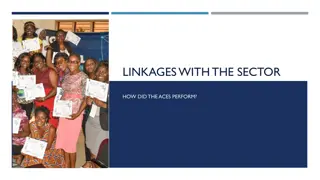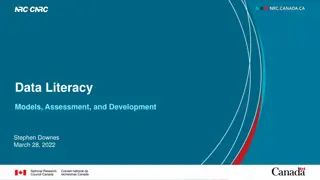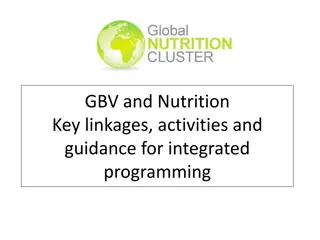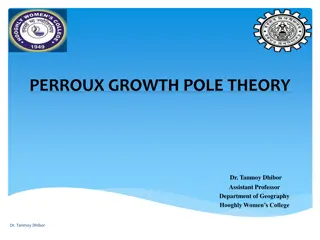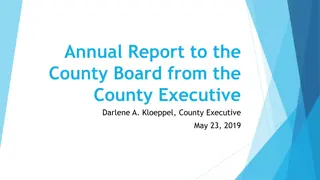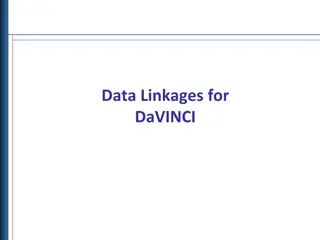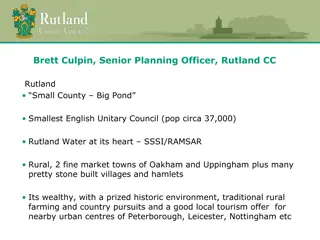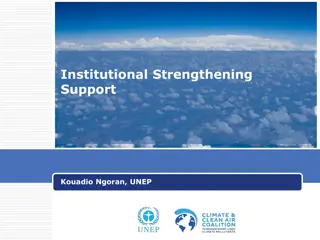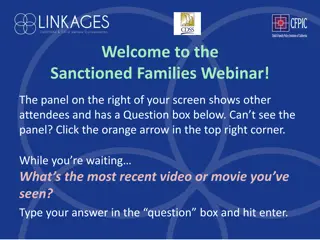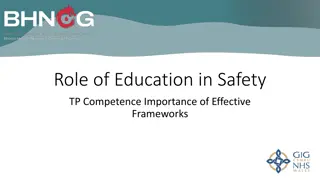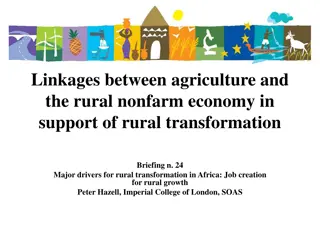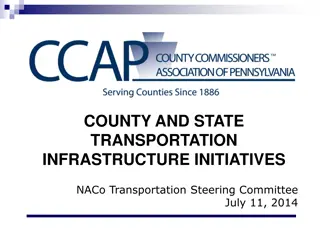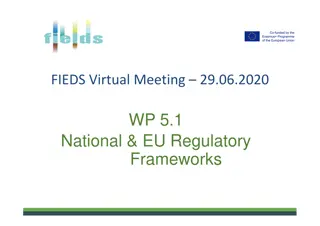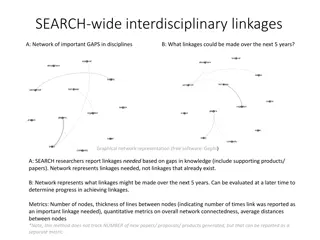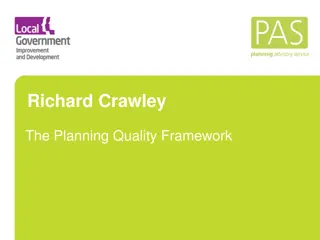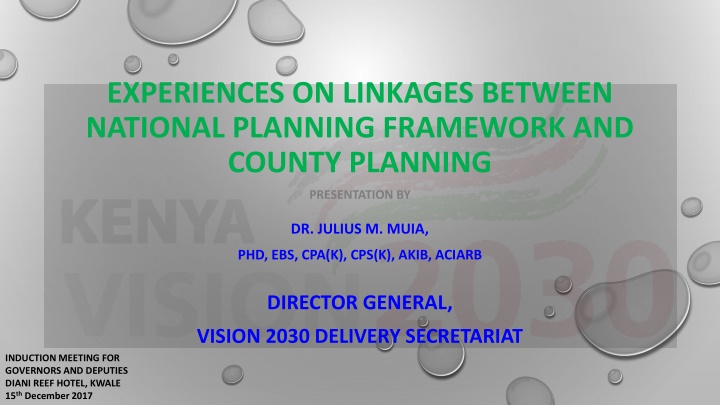
Linkages Between National and County Planning Frameworks
Connection between Kenya's Vision 2030 and county planning, highlighting collaboration, integration experiences, and moving forward collectively. Understand the role of the national planning framework and its impact on county-level development strategies.
Download Presentation

Please find below an Image/Link to download the presentation.
The content on the website is provided AS IS for your information and personal use only. It may not be sold, licensed, or shared on other websites without obtaining consent from the author. If you encounter any issues during the download, it is possible that the publisher has removed the file from their server.
You are allowed to download the files provided on this website for personal or commercial use, subject to the condition that they are used lawfully. All files are the property of their respective owners.
The content on the website is provided AS IS for your information and personal use only. It may not be sold, licensed, or shared on other websites without obtaining consent from the author.
E N D
Presentation Transcript
EXPERIENCES ON LINKAGES BETWEEN NATIONAL PLANNING FRAMEWORK AND COUNTY PLANNING PRESENTATION BY DR. JULIUS M. MUIA, PHD, EBS, CPA(K), CPS(K), AKIB, ACIARB DIRECTOR GENERAL, VISION 2030 DELIVERY SECRETARIAT INDUCTION MEETING FOR GOVERNORS AND DEPUTIES DIANI REEF HOTEL, KWALE 15th December 2017
OUTLINE 1. NATIONAL LEVEL PLANNING FRAMEWORK : KENYA VISION 2030 AND MEDIUM TERM PLANS 2. LINKAGES WITH COUNTY LEVEL PLANNING FRAMEWORK 3. SAMPLES OF COLLABORATION 4. EXPERIENCES: NATIONAL AND COUNTY FRAMEWORK INTEGRATION 5. CONCLUSION: MOVING FORWARD TOGETHER
KENYA VISION 2030 The Overarching Vision: To make Kenya a globally competitive and prosperous nation with a high quality of life by 2030 To Note: It provides a rallying point for all counties The sum total of 47 County Governments projects/activities/outputs will determine whether Vision 2030 is achieved. 4 4
A VISION FOR A COMPETITIVE KENYA Overarching Vision A globally competitive and prosperous nation with a high quality of life by 2030 5 Vision Political An issue-based, people-centered, result-oriented, and accountable democratic political system Social Economic To maintain a sustained economic growth of 10% p.a. for most of the next 20 years A just and cohesive society enjoying equitable social development in a clean and secure environment Strategy Plans and implementation Enablers and Macro - Foundations Cross cutting infrastructural development, STI, Public Sector Reforms and Macroeconomic stability National Value System
PROCESS TOWARDS VISION 2030 i. ii. Basis for Kenya s Development Planning at National and Sub- National Level iii. Identifies and specifies a clear path for national development iv. Government role is to create enabling environment while private sector is the Engine of Economic Growth v. Inclusivity: All sectors and whole country (geography) vi. Ambitious plans where >70% of the finance will be from the private sector vii. Provides for the institutional framework for implementation, monitoring and evaluation of the Vision viii.Has log frame structure (Goal; Strategic Objective, Activity, Output) Launched in June 2008
THE IMPLEMENTATION OF VISION 2030 VISION 2030 IS IMPLEMENTED THROUGH 5 YEAR MEDIUM TERM PLANS (MTPs) MTP I MTP II MTP III 2008 -2012 2013 2017 2018-2022 (UNDER PREPARATION) COUNTIES ARE EXPECTED TO ALIGN THEIR STRATEGIC PLANS AND COUNTY INTEGRATED DEVELOPMENT PLANS (CIDPS) TO THE VISION 2030 NATIONAL DEVELOPMENT BLUE PRINT AND THE MTPs THROUGH A CONSULTATIVE PROCESS
TRANSVERSAL REFORMS AND FOUNDATIONS OF VISION 2030 The THREE Pillars of Vision 2030 are anchored on foundations of society that undertake reforms in 11 key sectors for socio-political and economic growth. The Foundations are: 1.Macroeconomic stability for long term development 2.Continuity in Governance Reforms 3.Enhanced Equity and wealth creation opportunities for the poor 4.Infrastructure (Transport, Ports, Telecom, etc) 5.Energy (Electricity etc) 6.Science, Technology and Innovation (STI) 7.Land Reforms 8.Human Resource Development 9.Security 10.Public Service 11.National Values and Ethics
SOCIAL PILLAR TO BE ABLE TO INVEST IN THE PEOPLE OF KENYA, THE FOLLOWING STRATEGY IS KEY Undertake transformation in 6 key social sectors A just and cohesive society enjoying equitable social development in a clean and secure environment 1. 2. 3. 4. 5. 6. Education and Training Health Water and Sanitation Environment Housing and Urbanization Gender, Youth and Vulnerable groups
POLITICAL PILLAR TO ACHIEVE THIS SO AS TO MOVE TO THE FUTURE AS ONE NATION THE FOLLOWING STRATEGY IS KEY Transformation of the Kenya s political governance across 5 strategic areas. An issue-based, people-centred, result-oriented, and accountable democratic political system 1. 2. 3. 4. 5. Rule of Law and human rights Electoral and political processes Democracy and public service delivery Transparency and accountability Security, peace building and conflict resolution
Kenya Vision 2030 has identified 8 priority sectors to drive economic growth by sp ecifying sectors and flagship projects to anchor major investment opportunities for the private sector OIL & GAS, MINERALS BLUE ECONOMY
TRANSFORMATIVE FLAGSHIP PROJECTS 2013-2017 _________________________________________ No. of Flagship Projects _________________________________________ Economic Pillar 36 Social Pillar 76 Political Pillar 6 Enablers and Macro 64 _________________________________________ TOTAL 182 _________________________________________
INSTITUTIONALIZING VISION 2030 IN PLANNING, BUDGETING AND IMPLEMENTATION Vision 2030 Step 1 Since its launch in June 2008, Vision 2030 has provided the only official base for government development planning Medium Term Plans I, II, III (24 Sector Working Groups based on Vision 2030 Sectors) Step 2 Medium Term Expenditure Frameworks (3 year rolling) Annual Budgets Step 3 Strategic Plans by Ministries, Departments and agencies County Integrated Development Plans (CIDP) Modular structure ensures ease of extracting Medium Term Plans Step 4 Annual Plans Step 5 Annual Performance Contacts Comprehensive and inclusive nature ensures universal acceptance Step 6 Mid-term and End of Term Monitoring and Evaluation Reports Step 7
COUNTY GOVERNMENTS AND VISION 2030 Lead Agency/Implementer The lead agency/implementer is the MDA under whose mandate the flagship project or other project falls under. The lead agencies/implementers have overall responsibility including the planning and execution of the projects in accordance with their mandate. Devolved Functions remain the responsibility of County Governments. County Governments need to carefully examine the flagship projects matrix and see the role they play as collaborators
DELIVERING KISUMU AIRPORT AS A FLAGSHIP PROJECT Deliver Kisumu Land Roads Airport Security Airport Lead Agency Ministry of In charge of Transport (Kenya Airports Authority) Kisumu County Govt. Ministry of Lands Ministry of Transport & Infrastructure Ministry of Internal Security Implementers
DELIVERING ISIOLO RESORT CITY AS A FLAGSHIP PROJECT Land Roads Airport Security Deliver resort city Lead Agency Ministry of Tourism Isiolo County Govt. Ministry of Lands Ministry of Transport & Infrastructure Ministry of Internal Security Implementers
COUNTY GOVERNMENT VISION 2030 INDICATORS Approval of Physical Plan and Master Plan Community sensitization, through stakeholders forums Resettlement of current residents within the project area. Integrating the project into the County Master Plan
EXPERIENCES: NATIONAL AND COUNTY FRAMEWORKS INTEGRATION
THE PERCEPTION OF VISION 2030 AT NATIONAL LEVEL BY IMPLEMENTERS Based on your general and other knowledge, please score the 24 Vision 2030 Sectors according to their performance towards full implementation of Vision 2030 flagship projects to date. Questionnaire Administered to 77 Implementers of Vision 2030 in June 2017 In ascending order, Score 0 is for least performance (e.g. nothing started/stalled sector) while Score 10 is for Highest/Full Achievement
PERCEIVED AVERAGE PERFORMANCE BY 1.0 SECTORS IN PILLAR - 2.0 3.0 4.0 5.0 6.0 7.0 8.0 9.0 10.0 Infrastructure (Roads, Ports & Rail) 7.1 Energy 6.6 6.6 Enablers and Macro Information & Comm Technology Public Sector Reforms Science Tech & Innovation 5.5 5.2 Land Reforms 4.5 10 Sectors Security, Peace Building and Conflict Resolution Labour and Unemployment National Values and Ethics Ending Drought Emergencies 4.3 3.8 3.8 3.1 Financial Services 6.0 Tourism 5.4 Economic Pillar 7 Sectors Whole sale, Retail and Trade Oil and Other Minerals Agriculture and Livestock Manufacturing Business Process Outsourcing Education and Training 5.0 4.9 4.7 4.7 4.4 6.2 Social Pillar 6 Sectors Health 5.6 Environment, Water and Sanitation Population, Urbanization and Housing Gender, Youth and Vulnerable Groups Sports, Culture and Arts 4.9 4.3 5.4 4.6 Political Pillar 2 Sectors Devolution 6.2 Governance, Judiciary and Rule of Law 5.4
PERCEIVED AVERAGE PERFORMANCE BY PILLAR The political pillar is deemed by the Implementers to have performed best among the four pillars of Vision 2030 with a perceived average achievement rate of 58%. Political Pillar 5.79 The other pillars scored below the grand average of 53% achievement rate Average is 5.26 which means 53% achievement rate Social Pillar 5.19 The Enablers and Macro scored the least in terms of perceived performance at 50.4%. Despite scoring very high in infrastructure (71%) , Energy (68%) and ICT(68%) , the overall score was pulled down by Ending Drought and Emergencies (31%); National Values and Ethic s(38%) and Labour and Unemployment (38%). Note also that Enabler s has 10 Sectors compared to 2 for the Political Pillar Economic Pillar 5.00 Enablers and Macro 5.04 - 2.00 4.00 6.00 8.00 10.00 The Economic Pillar was scored the least in performance at 50% with only two sectors out of SEVEN scoring above the average of 52.6% . These two are Financial Services
VISION 2030 DELIVERY SECRETARIAT INITIATIVES WITH COUNTIES 1. DEVELOPED MEMORANDA OF UNDERSTANDING (MOUs) WITH SOME COUNTIES TO IDENTIFY STRATEGIC AREAS OF ENGAGEMENT 2. COUNTY CONSULTATIONS ON MTP PROCESS, AND ALIGNMENT OF VISION 2030 AND CIDPs 3. COUNTY ROLE IN DISSEMINATION OF VISION 2030, AND BRANDING OF FLAGSHIP PROJECTS
COUNTY FORUM PARTICIPANTS SURVEY A SURVEY WAS CARRIED OUT AMONGST COUNTY FORUM PARTICIPANTS ON THEIR ASSOCIATION OF PROJECTS WITH VISION 2030. THEIR DISTRIBUTION BY COUNTIES IS AS BELOW: Samburu 3% Marsabit 3% Meru 3% Kwale 11% 1. Meru 2. Tharaka Nithi 3. Laikipia 4. Marsabit 5. Isiolo 6. Samburu 7. Wajir 8. Kisumu 9. Homa Bay 10. Siaya 11. Taita Taveta 12. Machakos 13. Makueni Tharaka Nithi 4% Kisumu 6% Makueni 10% Isiolo 6% Mombasa 10% Siaya 6% Taita Taveta 8% Homa Bay 7% Machakos 7% Laikipia 8% Kilifi 8%
PROJECTS ASSOCIATION WITH VISION 2030 BY COUNTY FORUM PARTICIPANTS Economic Pillar 7% Political Pillar 2% The County Forums Participants Associate Vision 2030 mainly with: Enablers and Macro (infrastructure projects) Social Pillar(free health and education) Enablers & Macro 54% Social Pillar 37%
NEXT STEPS Complete County Integrated Development Plans (CIDPs) Align CIDPs to Medium Term Plan III (MTP III) & Vision 2030 Develop own Performance Contracts Indicators (PCIs) Facilitate and develop laws to strengthen synergies of CIDPs with Vision 2030 & MTP III Call on us for any help in implementing Vision 2030
THANK YOU ASANTENI
Dr. Julius Muia jmuiavds@gmail.com Director General Vision 2030 Delivery Secretariat The Presidency, Republic of Kenya 2nd floor; KUSCCO Centre Upper hill Nairobi, Kenya. http//www.vision2030.go.ke http://www.facebook.com/kenyavision2030 www.twitter.com/kenyavision2030



